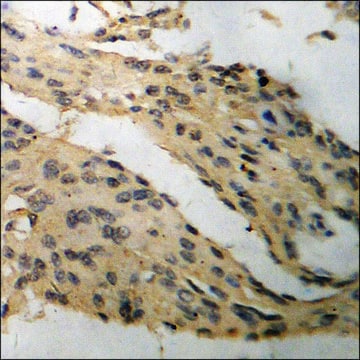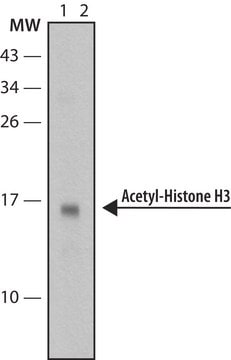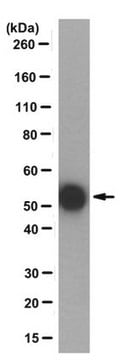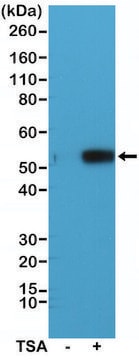04-119
Anti-acetyl-Histone H4 (Lys12) Antibody, rabbit monoclonal
culture supernatant, from rabbit
Sinonimo/i:
H4K12Ac, Histone H4 (acetyl K12)
About This Item
Prodotti consigliati
Origine biologica
rabbit
Livello qualitativo
Forma dell’anticorpo
culture supernatant
Tipo di anticorpo
primary antibodies
Clone
monoclonal
Reattività contro le specie
human, vertebrates
Produttore/marchio commerciale
Chemicon®
Upstate®
tecniche
ChIP: suitable
dot blot: suitable
western blot: suitable
Isotipo
IgG
N° accesso NCBI
N° accesso UniProt
Condizioni di spedizione
wet ice
modifica post-traduzionali bersaglio
acetylation (Lys12)
Informazioni sul gene
human ... H4C1(8359)
Specificità
Immunogeno
Applicazioni
Sonicated chromatin prepared from HeLa cells (1 X 10E6 cell equivalents per IP) were subjected to chromatin immunoprecipitation using either 2 µL of Negative Control Supernatant, or 2 µL of Anti-Acetyl-Histone H4 (Lys12) and the Magna ChIP A Kit (Cat. # 17-610).
Successful immunoprecipitation of Acetyl-Histone H4 (Lys12)-associated DNA fragments was verified by qPCR using ChIP Primers, human GAPDH Coding Region as a positive locus, and a gene desert region as a negative locus. (Figure 2). Data is presented as percent input of each IP sample relative to input chromatin for each amplicon and ChIP sample as indicated.
Please refer to the EZ-Magna ChIP A (Cat. # 17-408) or EZ-ChIP (Cat. # 17-371) protocol for experimental details.
Western Blot Analysis:
Lysates from HeLa cells untreated or sodium butyrate treated (Lanes 1 and 2 respectively) were resolved probed with anti-acetyl-Histone H4 (Lys12) (1:1,000). Arrow indicates Acetyl-Histone H4 (Lys12).
Arrow indicates Acetyl-Histone H4 (Lys12) (~11 kDa)
Epigenetics & Nuclear Function
Histones
Chromatin Biology
Qualità
Descrizione del bersaglio
Stato fisico
Stoccaggio e stabilità
Note legali
Esclusione di responsabilità
Not finding the right product?
Try our Motore di ricerca dei prodotti.
Codice della classe di stoccaggio
12 - Non Combustible Liquids
Classe di pericolosità dell'acqua (WGK)
WGK 1
Punto d’infiammabilità (°F)
Not applicable
Punto d’infiammabilità (°C)
Not applicable
Certificati d'analisi (COA)
Cerca il Certificati d'analisi (COA) digitando il numero di lotto/batch corrispondente. I numeri di lotto o di batch sono stampati sull'etichetta dei prodotti dopo la parola ‘Lotto’ o ‘Batch’.
Possiedi già questo prodotto?
I documenti relativi ai prodotti acquistati recentemente sono disponibili nell’Archivio dei documenti.
Il team dei nostri ricercatori vanta grande esperienza in tutte le aree della ricerca quali Life Science, scienza dei materiali, sintesi chimica, cromatografia, discipline analitiche, ecc..
Contatta l'Assistenza Tecnica.








